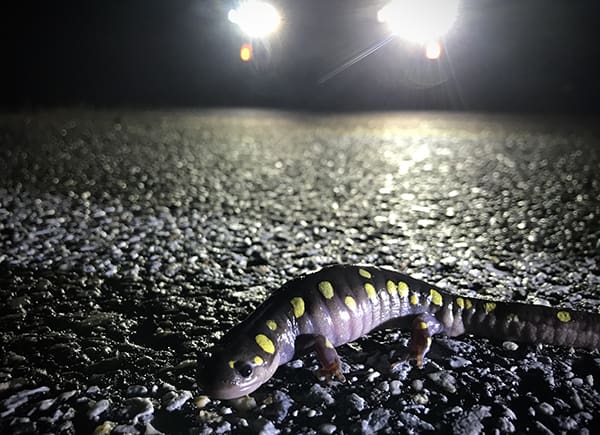
Spotted Salamander — VTF&W is asking drivers to be cautious when traveling at night in early spring or to take alternate routes to avoid driving near ponds and wetlands where salamanders and frogs are crossing during their breeding season.
Vermonters are reporting a particularly horrendous mud season this year, keeping some off the roads. But the warm, rainy nights in early spring give us another good reason to avoid even the paved roads. Breeding frogs and salamanders are on the move.
“At this time of year, amphibians cross roads in large numbers to reach vernal pools and other waters for breeding,” says Fish & Wildlife herpetologist Luke Groff. “If you find a crossing, you can see many individuals and species in a short period and small area, and some species may not be seen the rest of the year. Spotted and blue-spotted salamanders, for example, belong to a group called the ‘mole salamanders’ because after breeding, they retreat underground or under logs or stumps and are rarely seen until the following spring.”
Biologists rely on amphibian road crossing events to document rare or otherwise hard-to-find species. For example, the four-toed salamander is rare in Vermont, and its distribution is not well understood.
This information is used by Fish & Wildlife, the Agency of Transportation and other conservation partners to assess the need for wildlife passages and barriers in road construction plans that allow all wildlife, not just frogs and salamanders, to more safely cross roadways.
Groff is encouraging Vermonters to explore their nearby roads and report amphibian road crossings to the Vermont Reptile and Amphibian Atlas at vtherpatlas.org/. If you can safely take photos of the amphibian species crossing, please include them.
Vermonters who wish to contribute to the Fish & Wildlife Department’s work to help frogs and salamanders can donate to the Nongame Wildlife Fund on their state income tax form or on the Vermont Fish & Wildlife website. Visit: vtfishandwildlife.com.



